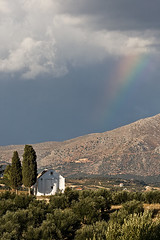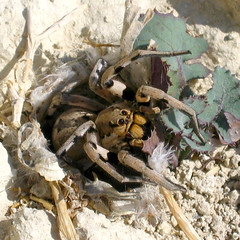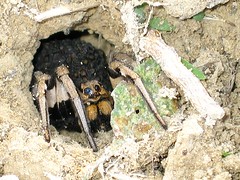This photo, captured on my way to work last Wednesday, makes me feel realy lucky, for being in the right place, at the right time. I pass by this spot twice a day, sometimes stopping for a couple of shots, as I like the landscape. In fact, I've already posted three photos of the same place in the past [1] [2] [3].
But that particular morning, when I realized that a rainbow was forming, I hit the brakes so hard that I would've caused an accident had some other car been following behind me! I got out and started snapping shots with my 35mm, but I wasn't satisfied at all with the results... Then, this very composition formed in my mind, so I changed into my 100mm and actively sought out the angle that would put the rainbow and the building in opposite corners, while fitting them in a tight frame (this is exactly what I shot, no crop). This meant jumping over a fence and treading on muddy ground, but I believe the result was worth the trouble :-)
Wednesday, November 26, 2008
Right place, right time
Monday, November 3, 2008
Early days: Overcoming arachnophobia
In my previous posts, I've covered the fact that dragonflies have been my main fascination in the world of nature photography. Now let me tell you a bit about my encounter with a spider, that helped me overcome my inherent arachnophobia and allowed me to broaden my horizons and include previously considered "dangerous" critters in my subjects' list, like spiders, scorpions, centipedes, wasps and the like...
I had read about wolf-spiders before, all about their burrowing lairs and their unique "motherly care", but I had never thought I would encounter one, let alone outside my house! It was our first year in our newly built house in the countryside, when in late August 2006, I spotted a suspicious looking hole in our garden next to the parking lot. After some examination, I realized that a hole in the dirt, with a diameter of about 2cm, its interior lined with silk web, could only belong to a spider, a wolf-spider to be specific (family: Lycosidae)! For a few days I was both terrified and excited about the discovery: excited that I could potentially see with my own eyes a creature that this far had belonged to photos from far-away exotic places, but also terrified at the thought that maybe my family and I were in danger of getting bit by such a "fiend"!
For a few days, I was all over the network trying to find more about lycosids and my fears were alleviated a bit by learning that these spiders were neither aggressive, nor dangerous to humans, at least not the species found throughout Europe. Their bite is supposed to be no more painful or dangerous than a bee sting. This fact made me relax a bit and the feeling of excitement got the best of me... Then on Saturday afternoon, August 26th, getting out of my car and pausing once more to look at the hole, I thought I saw movement inside and so decided to investigate...
I took a long twig and just barely entered it into the entrance of the hole and sure enough the spider (that apparently felt threatened) raced from inside her lair to the entrance and attacked it! I was taken by surprise by the speed she moved and I immediately let go of the twig and jumped back in fear, my heart racing (I'm pretty sure I must have screamed, too)! I stared at her for long moments in disbelief, or maybe I was just frozen in fear... At a body length of 2-3cm, she was the biggest spider I had ever seen: with her legs outstretched she was bigger than my palm!
But I quickly realized that she was probably more afraid of me than I was of her, because when I moved she quickly retreated back into her lair. So, I began to fight back my own fear, helped by the gallons of adrenaline my body was surely pumping by that time. Finally curiosity got the best of me and I decided to take out my camera. Using the twig technique to lure her out of her hole several times, I made some shots. The photo on the right was the best I could manage, with my Canon Powershot S45 and trembling arms :-)
I contacted a local arachnologist, Dr Maria Chatzaki, who identified the species as Lycosa praegrandis, which is the only big species of this family on the island of Crete. It was definitely a female, as male lycosids tend to be smaller than that and don't dig lairs (they just roam).
A few days later, on August 30th, I went to get my car at night and I spotted her silhouette on the parking lot floor (I told you her lair was in the garden next to the parking lot). I immediately ran back home to get my camera and I managed to get a few night shots of her with the flash.
On September 12th, just after the first autumn rain, I found out that she had closed the entrance to her lair using whatever debris she found around. I assumed that she was hibernating and was expecting to see her again in spring.
But on Saturday, October 16th, I was in for a surprise: I saw that she had once more opened her lair. At first, I thought that maybe the water from the recent heavy rains managed to flood her tunnel and she was forced out by that. Anyway I thought this was a great opportunity for some more captures and I tried to get her out the usual way (teasing her with a small twig). In the past, whenever I tried that, she was quick to get out of her lair and attack the twig, but this time, no matter how many times I teased her, she would kick the twig with her two front legs, touch it with her palps, even bite it with her fangs, but she refused to get her fat belly out of the tunnel!
I thought she was being plain lazy and eventually gave up and decided that I would settle for a shot of her posing at the entrance. I took a couple of photos and saw that only part of her legs and a little bit of face was visible and although I hated using the flash (because I thought it gave her a goofy look with one blue eye and one red!), I fired it up, in order to get as much of her hidden body as possible. That's when I realized the real reason why she refused to expose her whole body! She was fully packed with spiderlings!!! Thus I got to witness the wolf-spider's unique method of infant care. Immediately after the little spiders hatch and emerge from their protective silken case they clamber up their mother's legs and all crowd onto her abdomen where they'll stay until their first moult.
A few days later, flooding rains destroyed her lair, burying it under heaps of mud. I never saw this spider again, I'm not even sure she made it, but I sure hope she did! I also wish I encounter this species some day again, now that I have the equipment for a proper macro, I only hope I'll still be able to muster the courage to get on my knees in front of her and make the shots :-)




